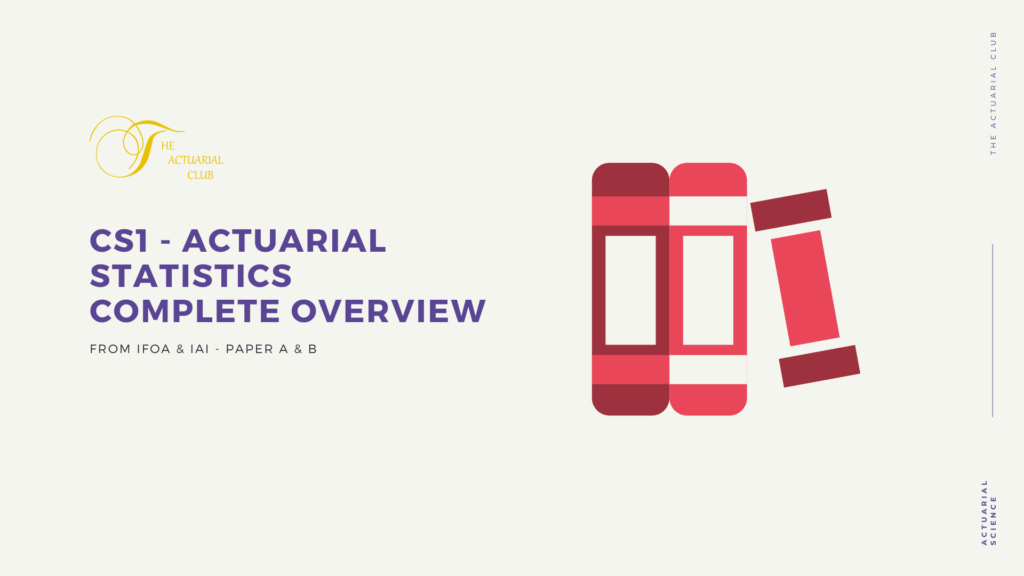The older subject CT3 (Probability and Mathematical Statistics) is now CS1 (Actuarial Statistics) subject under the new curriculum of IFoA and IAI (after 2019).
It is an exam that tests your statistical and analytical skills by marking how well you apply formulas, theorems, and statistical tests you study for problem-solving. It also strengthens your Data visualization and analysis capabilities if you study the concepts well.
A Closer Look at the CS1 Examination Structure
The exams from IAI and IFoA contain these two exams.
| CS1 – A Theory | CS1 -B Practical Exam |
| 3 hours and 15 minutes Theoretical Exam | 1 hour and 45 minutes Computer-based Exam |
| Tests formulas, and knowledge of applying those formulas to solve some problems. | Tests your knowledge of “R” Language and application of theory in R. |
| 100 Marks exam, with 70% weightage in total score. | 100 Marks exam, with 30% weightage in total score. |
♀ Both CS1 A and CS1 B need to be attempted in the same exam sitting.
♀ If your combined score from both A and B papers is above the passing mark, you will pass the subject. Otherwise, be ready to appear again for both papers.
Exploring the Topics for CS1 Exam Syllabus
The CS1 syllabus is an intricate tapestry woven with various statistical and mathematical concepts, including but not limited to:
- Probability Distributions and their Applications – Both discrete and continuous, The application of both and how to find Probability density functions?
- Moment and Generating Functions – Finding moment-generating functions for different random variables that follow some distributions
- Joint Distributions and the Central Limit Theorem – Use of different statistical tests such as T-test, Z test, etc in different situations
- Sampling Techniques and Hypothesis Testing
- Bias and Estimation Methods
- Linear and Generalized Linear Modeling
- Bayesian Statistics and Ruin Theory
- Correlation Measures
Topic Wise Weightage
| Sr. No. | TOPICS | WEIGHTAGE |
| 1. | Random Variables and Distributions | 20% |
| 2. | Data Analysis | 10% |
| 3. | Statistical Inference | 25% |
| 4. | Regression theory and applications | 30% |
| 5. | Bayesian Statistics | 15% |
CS1 B focuses on the R language. You can either study online through various websites like Youtube, DataCamp, Coursera, Udemy etc. or may want to take offline coaching for the same.
If you have a background in programming, you can also self-learn using the CS1 B- R material provided by the institute which tells how each concept from different chapters of the theory material can be applied in R.
Even without a background in programming, you can learn R using the CS1 B – R material which beautifully takes you from getting started with R (Installing it, performing basic arithmetics ) to some of the most advanced functions of R. All you need is a zest for learning it!
Focus on learning shortcuts and loops in R language as time is limited for a 100 mark paper and you may not want to waste it in writing long R codes.
You can discuss your doubts, questions and learnings on our forums dedicated to learning R here.
First, go through the core reading material for this exam. Solve all the examples, back exercise questions. Also, the X series Assignment at the back of the core reading material. Then practice past year papers and sample papers from IFoA. You can access Core reading and Specimen exam papers from IFoA here.
Having a strong conceptual knowledge is important for this subject so that you can relate things and apply them to solve relevant problems.
At a reduced rate, you pay GBP 200.00 (updated for 2024) for CS1 exam booking as a fee from IFoA.
Fees of other subjects from IFoA can be checked here.
You can appear for CS1 from IFoA only if you are a student member of this institute.
You can submit your application form online for becoming their student member. Once your application has been reviewed and cleared, you can book this exam for the upcoming exam sitting.
However, IFoA keeps updating its Student membership criteria. So you can check the latest information here.
The recommended hours for both CS1 A and CS1 B are 200 hours combined for study.
With the addition of R in the paper being the major change, the curriculum to study for the theory paper is more or less the same with the addition of a few more topics such as Bayesian Statistics, Measures of Correlation, Generalized Linear Regression etc. However, Compound distributions and ANOVA have been excluded from CS1 (which were a part of the old CT3 curriculum).
With the addition of R in the paper being the major change, the curriculum to study for the theory paper is more or less the same with the addition of a few more topics such as Bayesian Statistics, Measures of Correlation, Generalized Linear Regression etc. However, Compound distributions and ANOVA have been excluded from CS1 (which were a part of the old CT3 curriculum).
Other Actuarial Exams Helpful Links
| Actuarial Science Entrance for only IAI | ACET Exam – Pattern, Syllabus, Previous Year Question Paper |
| Core Mathematics in Actuarial Science | CM1 Core Mathematics 1 – Guide and Details CM1 TIPS & TRICKS CM2: History, Exemptions, Links & Syllabus |
| Core Statistics in Actuarial Science | CS1 Actuarial Statistics – Guide and Details |
| Core Business in Actuarial Science | CB1 (CT2) – Business Finance Tips & Tricks CB2 Business Economics – Guide & Details CB3 (CT9) Business Management : Guide & Details What is OPAT Exam by IFOA | Enrolment |Exam Structure and Preparation |
| Core Principles | CA2 / CP2 exam Paper 1 – Tips and Strategies |

